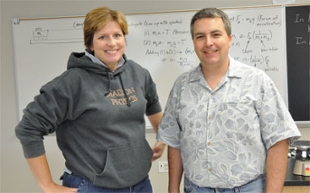JMU Professor 's Goal: Ease Shortage Of Physics Teachers
NewsBy JMU Public Affairs

It's not uncommon for high-school physics teachers to have little or no background in physics, especially in rural school districts such as those in the Shenandoah Valley.
If you find that alarming, you're not alone.
"There is an extraordinary dearth of physics teachers and physical science teachers in this country and there have been congressional reports lamenting the fact that there aren't enough out there to keep the United States scientifically, technologically competitive in the coming years," said Mark Mattson, assistant professor of physics and astronomy at JMU.
And while Virginia law requires high-school teachers to have degrees in the subjects they teach, there are ways around it.
"If you're an administrator and you need to offer physics because students are signing up for it, you'll take a chemistry major straight out of college and give him a provisional," said Lynn Lucatorto, a former physics teacher at Spotswood High School in Rockingham County. "So there are teachers teaching physics who do not have a teaching certification and who did not even major in physics. It's because the need is so great. It's happening more so in areas like this where you have a school that couldn't hire a full-time teacher, where they'd be part-time physics and part-time something else."
Mattson is doing what he can to alleviate the problem by running a teacher-in-residence program. The program, funded through a $255,365 grant from the Toyota USA Foundation, enables Mattson to hire one high-school physics teacher a year to work in the JMU physics department. During the year, the teacher-in-residence is required to teach a physics course and to help the department in other ways. In return, the teacher gains updated skills, resources to help them when they return to teaching in the public schools, and a heightened awareness of the skills high-school students need to prepare for college.
"I have changed aspects and the focus of the introductory physics lab at Shenandoah Valley Governors School because of conversations I had with JMU physics faculty members," said Thomas O'Neill, the teacher-in-residence for 2008-2009. "I have incorporated material and Web sites that they have recommended. I can't stress enough the benefits of just talking physics with someone else. I am the only physics teacher in the building at SVGS."
Mattson modeled the program after one he heard about at a conference of the Physics Teachers Education Consortium. "When I learned about this, I thought this would be great for JMU because there's really no institution in this part of the country that has such a program," he said. "I want to get more physics teachers out in the work force and also make sure that the physics teachers currently out there have a good background in physics."
The program benefits JMU too. The teachers-in-residence can tell prospective teachers "what it's like in the trenches," Mattson said, and they can encourage undergraduates who may not be planning to teach, to consider teaching as a career. That can be a difficult sell in the science, technology, engineering and mathematics (STEM) fields, where teaching salaries are generally lower than what's offered in other professions.
"The ones that choose teaching do it for other values, the lifestyle," said Lucatorto, this year's teacher-in-residence. "I chose it because in engineering, if I took off years to raise my family, I wasn't going to walk right back into my job." Some of the benefits of teaching, Lucatorto said, are having the same holidays as children, being able to coach athletics and academics, and having time for community involvement.
"I have changed aspects and the focus of the introductory physics lab at Shenandoah Valley Governors School because of conversations I had with JMU physics faculty members. I can't stress enough the benefits of just talking physics with someone else." —Thomas O'Neill, the teacher-in-residence for 2008-2009.
In addition to benefiting JMU students and the department of physics and astronomy, the teacher-in-residence program may also benefit JMU's recruiting efforts. "I want the TIRs and the teachers who come here for the summer programs to look at JMU and say, 'This place is pretty good. I'll definitely tell my students this is a good place to go,'" Mattson said.
The program made a good impression on O'Neill. "JMU is doing an excellent job of readying its prospective teachers. I was impressed by the professional demeanor and poise, and also gratified to see innovative lessons that incorporated novel, at least to me, techniques," he said.
While the program sounds like a winner, there are difficulties running it, especially in rural areas where it is needed most.
"One of the things we've asked for when looking for teachers is that they not have to travel beyond a couple hundred miles from where they are," Mattson said. "We've been trying to keep it in the region. And naturally that's going to limit your pool of qualified candidates. And there's not a large pool of physics teachers who I'm able to pry away from the school for a year."
"The school has to want to let them go," said Lucatorto, who would like to return to teaching at Spotswood High School. "They don't want to go a year without a physics teacher, which is what they have to give up."
To be able to teach at JMU, the teacher-in-residence must also have at least a master's degree in physics or physics education.
The difficulties, however, are not deterring Mattson from seeking another grant to extend the program, which the Toyota USA grant has funded for three years. In addition to paying for the TIR position, the grant has paid for teachers to lead weeklong summer workshops, for follow-up fall workshops, and for workshop registration fees and travel costs.
"In the long run, hopefully we'll have a few more physics teachers out there. This is definitely one of those long-term vision sorts of things," Mattson said.

